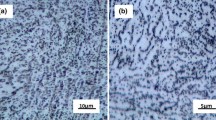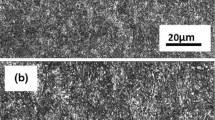Abstract
On the basis of the processes of initiation and growth of voids at grain boundaries, the authors develop a physicomechanical model of intergranular cavitation failure of polycrystalline materials. The model can be used to predict endurance in static and cyclic loading structural members in a multiaxial stress state and at a variable strain rate. An approach to describing the effect of this rate on the nature of failure of the material and transition from intragranular to intergranular failure is formulated.
Similar content being viewed by others
Literature cited
F. MacLintock and A. Argon, Strain and Fracture of Materials [Russian translation], Mir, Moscow (1970).
Ya. B. Fridman, Mechanical Properties of Metals [in Russian], Vol. 1, Mashinostroenie, Moscow (1974).
L. A. Kopel'man, Brittle Fracture Resistance of Welded Sections [in Russian], Mashinostroenie, Leningrad (1978).
J. F. Nott, Fundamentals of Fracture Mechanics [Russian translation], Metallurgiya, Moscow (1978).
D. Broek, Fundamentals of Fracture Mechanics [in Russian], Vysshaya Shkola, Moscow (1980).
J. Cadek, Creep of Metallic Materials [Russian translation], Mir, Moscow (1987).
R. P. Skelton (ed.), Fatigue of Materials at High Temperatures [Russian translation], Metallurgiya, Moscow (1988).
S. T. Rolfe and J. M. Barsom, “Fracture and fatigue control in structure,’ in: Application of Fracture Mechanics, Prentice-Hall, New Jersey (1977).
H. O. Fuchs and R. I. Stephens, Metal Fatigue in Engineering, Wiley, New York (1980).
H. Liebowitz (ed.), Fracture [Russian translation], Vol. 3, Mir, Moscow (1976).
V. Sklenicka, V. Kucharona, J. Foldyna, and J. Cadek, “Interrelationship between creep deformation and creep rupture in a low alloy CrMoV steel after service,’ in: Creep and Fracture of Engineering Materials and Structures, Institute of Metals, London (1987), pp. 361–370.
Bruce A. Kschinka and J. F. Stubbins, “Creep-fatigue environment interaction in bainitic 2.25 wt. % Cr-1 wt. % Mo steel forging,’ Mater. Sci. Eng.,A110, 89–102 (1989).
B. Wilshire and R. W. Evans (eds.), “Creep and fracture on engineering materials and structures,’ Institute of Metals, London (1987).
J. C. Harthman, G. Eggeler, and B. Ilschner, “Deformation and damage processes in a 12% CrMoV steel under high temperature low cycle fatigue condition in air and vacuum,’ Mater. Sci. Eng.,A110, 103–104 (1989).
K. Bhanu Sankaka Rao, H. Schiffers, H. Schuster, and H. Nickel, “Influence of time and temperature dependent processes on strain controlled low cycle fatigue behavior of alloy 617,’ Met. Trans.,A19, No. 2, 359–371 (1989).
C. Levaillant, J. Grattier, M. Mottot, and A. O. Pineau, “Creep and creep-fatigue intergranular damage in austenitic stainless steel,’ in: ASTM Spec. Techn. Publ., No. 942, ASTM, Philadelphia (1988), pp. 414–437.
J. Polak, J. Helesic, and M. Klesnil,“Effect of elevated temperatures on the low cycle fatigue of 2.25 Cr-1 Mo steel. Part 1. Constant amplitude straining,’ in: ASTM Spec. Techn. Publ., No. 942, ASTM, Philadelphia (1988), pp. 43–57.
R. Pigues, Ph. Bensussan, and A. Pineau, “Crack initiation and growth under creep and fatigue loading of an austenitic stainless steel,’ Nucl. Eng. Design,116, No. 3, 293–306 (1989).
G. P. Karzov, B. Z. Margolin, and V. A. Shvetsova, “Physicomechanical approaches to analysis of the macroscopic fracture criteria. Report I. Fatigue fracture,’ Probl. Prochn., No. 6, 7–14 (1989).
G. P. Karzov, O. V. Kuklina, and B. Z. Margolin, “Physicomechanical approaches to analysis of the macroscopic fracture criteria. Report 2. Ductile fracture,’ Probl. Prochn., No. 8, 3–10 (1989).
G. P. Karzov, B. Z. Margolin, and V. A. Shvetsova, “Physicomechanical approaches to analysis of macroscopic fracture criteria. Report 3. Brittle fracture,’ Probl. Prochn., No. 7, 12–21 (1989).
A. Needleman and J. R. Rice, “Plastic creep flow effect in the diffusive cavitation of grain boundaries,’ Acta Metal.,28, No. 10, 1315–1332 (1980).
I. W. Chen, A. S. Argon, “Diffusive growth of grain boundary cavities,’ Acta Metal.,29, No. 12, 1759–1768 (1981).
N. E. Peyton and K. A. Hamilton (eds.), Superplastic Forming of Structural Alloys [Russian translation], Metallurgiya, Moscow (1985).
N. A. Makhutov, Strain Fracture Criteria and Calculation of the Strength of Structural Members [in Russian], Mashinostroenie, Moscow (1981).
A. F. Gusenkov and P. I. Kotov, Long-Term and Nonisothermal Low-Cycle Strength of Structural Members [in Russian], Mashinostroenie, Moscow (1988).
B. I. Cane, “Deformation-induced intergranular creep cavitation in alpha-iron,’ Met. Sci.,12, No. 2, 102–108 (1978).
I. W. Chen and A. S. Argon, “Creep cavitation in 304 stainless steel,’ Acta Metal.,29, No. 10, 1321–1333 (1981).
O. V. Kuklina and B. Z. Margolin, “Physicomechanical model of cavitation failure in creep,’ Probl. Prochn., No. 10, 23–29 (1990).
Raj, “Crack nucleation at grain boundaries in steady and cyclic creep conditions,’ Trans. ASME, J. Basic Eng.,98, No. 2, 41–51 (1976).
M. V. Speight and W. Beere, “Vacancy potential and void growth on grain boundaries,’ Met. Sci.,9, No. 3, 180–191 (1975).
W. Dahl and V. Anton (eds.), Static Strength and Fracture Mechanics of Steels [Russian translation], Metallurgiya, Moscow (1986).
S. Gary and S. M. Bruemmer (eds.), “Grain boundary chemistry and intergranular fracture,’ Trans. Tech. Publ., Switzerland-Germany-UK-USA (1989).
V. Suryanarayanan, K. J. L. Iver, and V. M. Radhakrishnan, “Interaction of low temperature hot corrosion and creep,’ Mater. Sci. Eng.,A112, No. 2, 107–116 (1989).
E. Lenz and N. Weiling, “Strain-induced corrosion cracking of low-alloy steel in LWR systems—interpretation of susceptibility by means of a three-dimensional (T, ɛ, dissolved oxygen) diagram,’ Nucl. Eng. Des.,91, No. 3, 331–344 (1986).
Yu. N. Rabotnov, Creep of Structural Members [in Russian], Nauka, Moscow (1966).
L. M. Kachanov, Fundamentals of Fracture Mechanics, Nauka, Moscow (1974).
A. A. Chizhik and Yu. K. Petrenya, “Kinetic equations of damage in evaluating the service life and reliability of materials under creep conditions,’ Tr. Tsentr. Konstr. Tekhnol. Inst.,194, 27–37 (1982).
A. G. Gulenko, G. P. Karzov, and B. Z. Margolin, “Using the finite element method to solve a viscoplastic problem in static and cyclic loading,’ Sudostroit. Promst. Ser. Materialoved., No. 8, 12–19 (1989).
N. N. Malinin, Applied Theory of Plasticity and Creep [in Russian], Mashinostroenie, Moscow (1975).
V. I. Makhnenko, “The variance-difference method for analysis of strain fields under nonisothermal loading,’ in: Strain Fields in Low-Cycle Loading [in Russian], Nauka, Moscow (1979), pp. 79–107.
O. K. Zienkiewicz, Finite Element Method in Technology [Russian translation], Mir, Moscow (1975).
V. I. Kostylev and B. Z. Margolin, “Finite element solution of a dynamic elastoplastic problem in fracture mechanics. Report 2. Subcritical crack propagation,’ Probl. Prochn., No. 7, 12–19 (1990).
Author information
Authors and Affiliations
Additional information
Translated from Problemy Prochnosti, No. 2, pp. 3–14, February, 1991.
Rights and permissions
About this article
Cite this article
Margolin, B.Z., Shvetsova, V.A. Effect of strain rate on the nature of failure in static and cyclic loading. Report 1. Formulation of general approaches. Strength Mater 23, 107–121 (1991). https://doi.org/10.1007/BF00770799
Received:
Issue Date:
DOI: https://doi.org/10.1007/BF00770799




